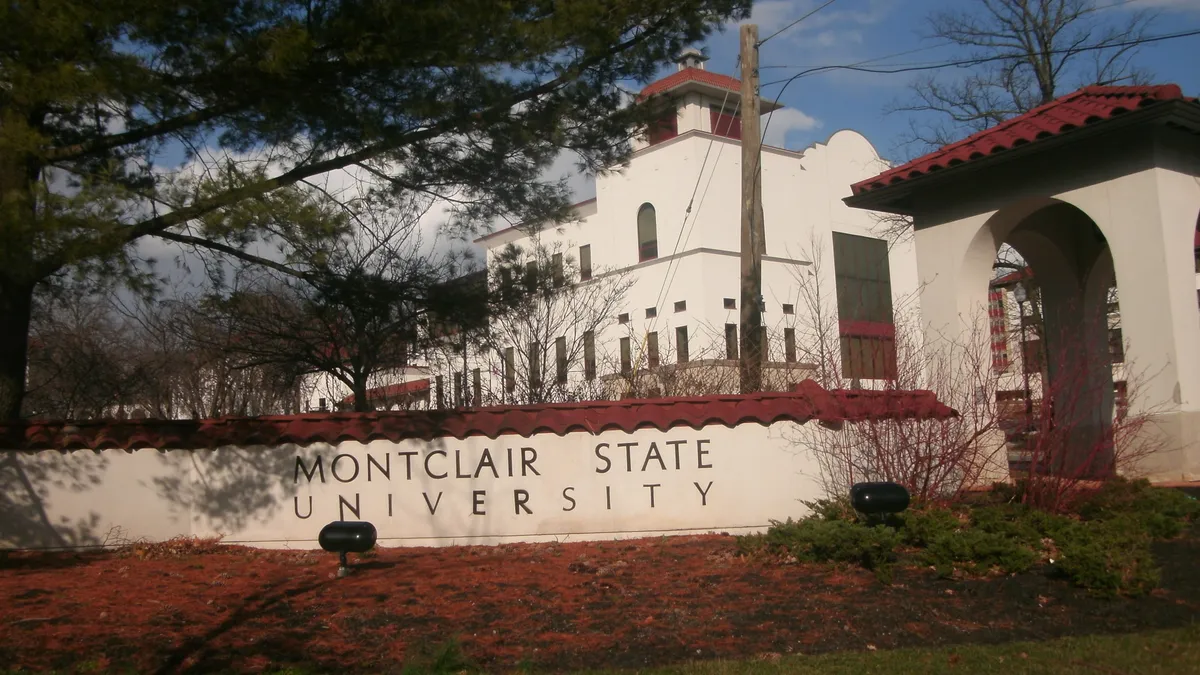Dive Brief:
- Montclair State University will absorb Bloomfield College when the academic year ends, the two institutions announced Wednesday, roughly a year after Bloomfield publicly asked for philanthropic support or a merger partner so it could remain open.
- The deal has been approved by governing boards at Montclair State, a public institution in northern New Jersey, and Bloomfield, a private nonprofit about 6 miles away.
- Plans call for Bloomfield to stop operating independently and become known as Bloomfield College of Montclair State University after the current 2022-23 academic year. The acquisition is slated to close by June 30, provided it receives approval from accreditors, regulators and state lawmakers.
Dive Insight:
Montclair State and Bloomfield have been tied together for months since Montclair State's governing board in March authorized the university to provide funding for Bloomfield while the two sides worked on a merger agreement. The board did so after Bloomfield said in October 2021 that it needed "a substantial source of funding" to remain open amid declining enrollment exacerbated by the COVID-19 pandemic.
Bloomfield's enrollment has been on a long downward slide. In fall 2009, it counted 2,156 students. This fall, it has just 1,153. The college hasn't been able to boost first-year enrollment either. It had 866 first-year students in fall 2009 and only 449 in fall 2021. This fall, the number of first-year students declined further to 377.
That's particularly concerning for the college's finances because, like many small private institutions, it depends on tuition to balance its budget. The situation also raises concerns from a college access standpoint because Bloomfield counts itself as New Jersey's only four-year college recognized simultaneously as a predominantly Black institution, Hispanic-serving institution and minority-serving institution.
Over 81% of Bloomfield's students are people of color, the college reported. Almost 70% are eligible for Pell Grants, which typically go to students from low-income families. Students' median family income is under $33,000.
In contrast to Bloomfield's enrollment trends, Montclair State just touted the largest enrollment in its history. Its incoming class this fall numbered 4,065 students, raising its total enrollment to 21,671 students.
About four in 10 of Montclair State's first-year class identify as Hispanic, and a similar ratio are the first in their families to attend college.
Leaders pointed to the institutions' similar focus on access as a reason the merger can be successful.
“The missions of both institutions are closely aligned,” the chair of Bloomfield's board of trustees, Vernon M. Endo, said in a statement. “It was clear that Montclair is as committed as we are to providing traditionally underserved students access to high-quality educational experiences and a pathway to social and economic advancement.”
Montclair State suggested the merger demonstrates a model under which institutions can stop competing when they operate near each other but have similar missions.
“Students enrolled at Bloomfield College will benefit from a distinctive educational environment offering a supportive, small college experience enhanced by the resources of a comprehensive public research university,” Montclair State's president, Jonathan Koppell, said in a statement.
Colleges across the country have turned to mergers as one strategy to adapt to a changing higher education market where fewer students have been enrolling in college — particularly in less-selective colleges. But successful mergers aren't always guaranteed, even after firm plans are announced.
This year, Marymount California University said it had to close after an attempted merger with a fellow Catholic institution, Florida's Saint Leo University, fell apart amid difficulty receiving accreditation approval. Also this year, the San Francisco Art Institute had to stop operating as a college after financial and compliance concerns scuttled a planned merger with the University of San Francisco.
In that light, it's notable that a range of stakeholders has shown support for the deal between Montclair State and Bloomfield. New Jersey allocated $12.5 million to Bloomfield to keep it open this year. Wednesday's merger announcement included supportive words from several lawmakers.
“I could not be more pleased that two minority-serving institutions are working together in this manner,” said Mila Jasey, who chairs the New Jersey General Assembly's higher education committee, in a statement. “The outstanding leadership of Presidents Marcheta Evans and Jonathan Koppell has crafted creative ideas and put generous state funding approved by the Legislature to good use, and the result is an innovative partnership."
Still, details remain to be ironed out. The two institutions must work on a transition plan, and it's not clear how many Bloomfield employees will transfer to Montclair state. A news release said the university will "make every effort to provide employment opportunities for Bloomfield College’s current employees."
It also said Bloomfield students will be able to continue in their education without interruption, promising they will not face extra costs.














